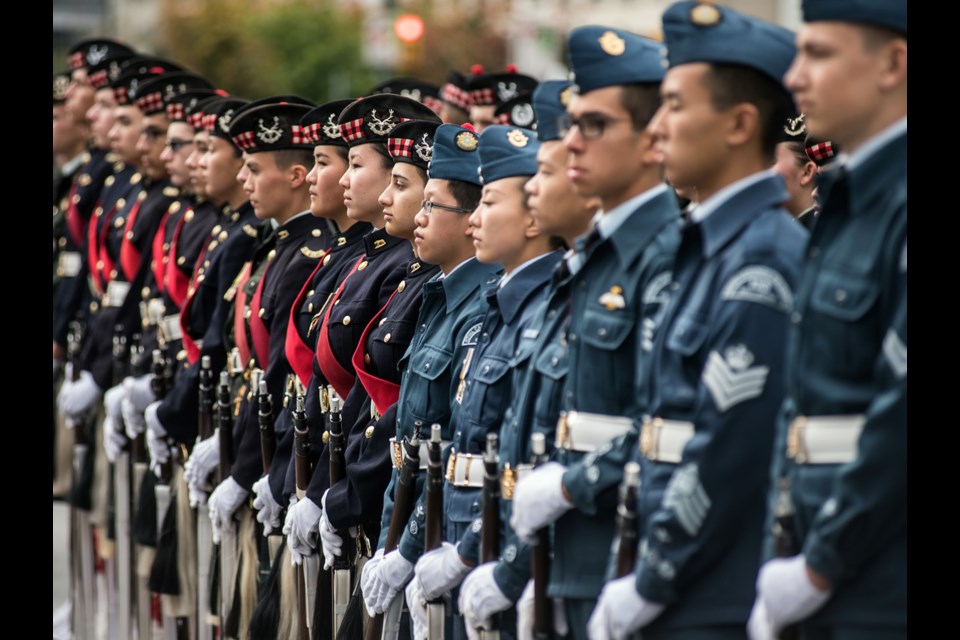There were many different levels of celebration for Rod Hoffmeister during Saturday’s return of the Seaforth Highlanders of Canada to their armoury, and they all had one common thread — pride.
The land on the corner of Burrard and First Avenue is now home to history as well as future. Next to the upgraded 80-year-old Seaforth Armoury that belongs to Vancouver’s reserve infantry regiment is the modern, four-storey, provincial headquarters for the Canadian Army. This building was named in honour of Hoffmeister’s father Lt.-Col. Bertram M. Hoffmeister whose many distinctions included leading Canadian troops in battle in Sicily during the Second World War, three Distinguished Service Order medals and commanding Canadian forces in the Pacific against Japan.
The name of the commanding officer of the Seaforth Highlanders was brought up in an officers’ mess during another presentation later in the day. Again, it was a long list of achievements linked to the late Hoffmeister, one that included being director of the B.C. Lions football club. This last distinction, when announced, elicited an enthusiastic, “Yeah!” from his good-natured son, Hon. Lieutenant-Colonel Rod Hoffmeister with the Seaforth Highlanders.
“It was very emotional,” said the younger Hoffmeister of the building dedication in his father’s name. “It’s a wonderful feeling to have him recognized, he was an outstanding Canadian in many regards.”
The day of celebration kicked off with the Seaforth Highlanders regiment and cadets marching to the armoury from Jericho Garrison followed by a regimental review, drumhead ceremony and highland homecoming tattoo (music, dancing, display of forces) that seemed to include most of the city’s piper, dance, and drummer population.
Hundreds attended the day’s ceremonies, which offered a rare glimpse into the armoury that’s normally locked down tight to the public. The only people making a regular appearance in the building for the last four years were the construction teams that seismically upgraded the armoury, as well as built the Major-General Bert Hoffmeister 39 Brigade facility. Improvements and construction cost $55 million.
“It’s been majorly upgraded with wiring, communications, seismic, and hopefully a couple holes were fixed in the roof that were there when we left,” said Hoffmeister. “It’s great to be back. It was four years of living in what was effectively our parent’s basement at Jericho. It wasn’t great but we all cooperated and got by.”
Moving back home will be gradual as the temporary offices still need to be packed, and the regiment is in training. Some decoration, by way of placing treasured photographs and artifacts on the walls, has begun, which is symbolic for Seaforths as they’re finally able to see a physical future beyond repair work. Members also look forward to recreating their museum and vast archives to give it the proper treatment that their previous cramped space couldn’t offer.
“It was a little room that could hold about five people and then it got claustrophobic,” said Hoffmeister.
The archives represent a long history that began Nov. 24, 1910, by a group of Vancouver residents of Scottish descent who started the infantry regiment. Seaforths served in both world wars and have been deployed on missions in Korea, Egypt, Croatia, Cyprus and Afghanistan. (Seaforths presented the regiment’s updated colours to display Afghan honours during Saturday’s ceremonies.) While they’re a reserve unit in the Canadian Forces — which means most members have day jobs — they are also trained to respond to local emergencies such as earthquakes, floods and fighting forest fires.
The freshly-painted white walls of the spacious parade ground’s interior displayed panels of photographs and drawings of soldiers in action and other important historical moments, along with informative descriptions. The walls, themselves, are now thicker to meet modern building requirements.
“We’ll see how it survives when the guys play floor hockey,” said Hoffmeister with a laugh. “I said, ‘OK guys, it’s just like playing on the street — you break a window, i.e. a panel, you pay for it!’”
rvblissett@gmail.com
@rebeccablissett



